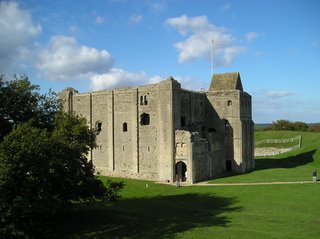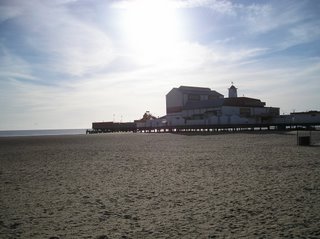Mum came to visit and, having done all the Cambridge things last year, needed to be entertained further afield. So we hired a car, an upgrade from the hire place to a Peugot 307s convertible - niiiiice, and set out into the hinterland. Friday, we went to Duxford Imperial War Museum where we checked out heaps of cool planes, including a Blackbird, a B52 and the first Concorde ever made, which one can walk inside.

 Definitely gives the National Air & Space Museum in Washington a run for its money.
Definitely gives the National Air & Space Museum in Washington a run for its money.The next day we set forth for Norfolk. First stop, Eric St John-Foti's Collectors World. "Possibly Norfolk's greatest eccentric and prolific collector, the original Mr 'Norfolk Punch' himself, Eric St John-Foti has displayed his extraordinary lifetime collections..."
Extra-ordinary, indeed. Some of it is set out thematically, eg. the Christmas rooms, highly redolent of the first scene of City of Lost Children:

Other sections are more random, but mindboggling nonetheless:

One of the newspaper articles likened E SJ-F to Norfolk's JP Getty, i think WR Hearst would be a more appropriate comparison. Definitely worth a visit though next time you're in the SW Norfolk area.
On to Castle Rising, the one time home of Queen Isabella, widow of Edward II and mother of Edward III.

This is the slot through which boiling oil would be poured on prospective invaders:

Further north to Sandringham. Our royalist tendencies were insufficient to provoke a full tour of the house but the gardens were very nice.

Next stop: Wells-next-the-sea, a charming fishing village next to the estuarine inlets that make up most of the coastline of north Norfolk.

 Then on to Great Yarmouth where we stayed that night. I think I preferred the ambience of Wells-next-the-Sea with only the creak of swaying boats and the occasional gull's cry over the peacefulness of the estuary (as opposed to drunken stags nights shouting and staggering out of mini-casinos and amusement arcades blaring happy-hardcore and poker-machine sounds).
Then on to Great Yarmouth where we stayed that night. I think I preferred the ambience of Wells-next-the-Sea with only the creak of swaying boats and the occasional gull's cry over the peacefulness of the estuary (as opposed to drunken stags nights shouting and staggering out of mini-casinos and amusement arcades blaring happy-hardcore and poker-machine sounds).
Still, we went for a very nice, more peaceful stroll along the beachfront the following morning:

There's a big windfarm project, Scroby Sands, 3 km off the coast - very interesting - the windmill towers are 60m high and the blades are 40m long - this is the future of renewable energy. If we're going to stop burning coal and oil, there'll need to be quite a few more of these set-ups around the country, and indeed around every country that gets a bit of breeze from time to time.

Eco-techno-philosophising aside, Great Yarmouth also afforded me the opportunity to purchase some Rock which has been a dream of mine ever since I moved to England.
Eating it has been a dream of mine too. Mmmm, touristy AND sugary.
Headed out to the Norfolk Broads.

Checked out the Broads Museum;
 looked at some yachts;
looked at some yachts;

and did a bit of sailing of my own.
 Learnt that the Broads were in fact partially manmade, resulting from water filling up holes left after peat had been dug out during the middle ages.
Learnt that the Broads were in fact partially manmade, resulting from water filling up holes left after peat had been dug out during the middle ages.
Next stop, after a hearty pub lunch Sunday roast, was Somerleyton House, a Victorian stately home built on the site of an early Jacobean mansion. Not quite as historical as, say, Audley End (scroll down) or Castle Rising, but the transition of the Victorian industrialists (like Sir Morton Peto, founder of Somerleyton house, and Sir Francis Crossley, who bought it from him) from entrepreneurial bourgeousie to semi-aristocratic landed gentry is an important aspect of English history. And the gardens are very nice.

I'd been harbouring aspirations of making it as far as Stratford St Mary's, the heart of Constable Country in South Suffolk, but it wasn't looking very promising. Consolation prize was Southwold Pier; nice coastline but bloody cold wind.

Keen to cram one more experience into the day, we stopped off at Framlingham Castle which is another mighty bit o' history in the middle of Suffolk.

No Constable, unfortunately, but a prolific tour nonetheless; fab to get out an about in the countryside and see a bit more of this sceptr'd isle.


0 Comments:
Post a Comment
<< Home